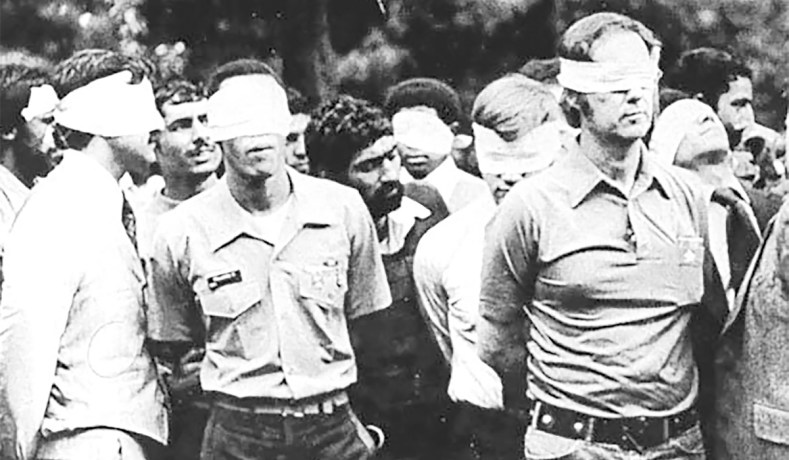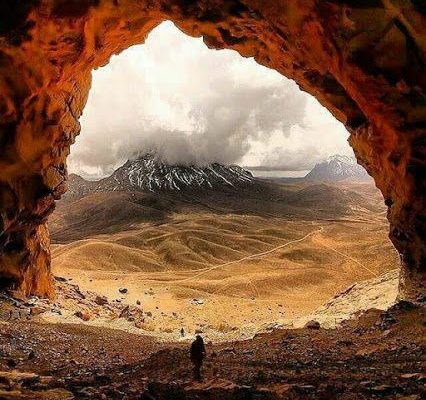For those who read my earlier three-part series on Nationalist Lessons from the Irish, you are aware of my thoughts on Nationalist movements in general. My heart is with Southern Nationalism; my soul is with Irish Nationalism. But intellectually, I fully embrace the fact that a win for Nationalist movements globally is a win for us all. Defeating the Globalists and their Marxist foot soldiers – especially their Cultural Marxist pawns – is important for the long-term vitality of all of our diverse cultures and righteous virtue. Learning from others as to how they succeeded should never be ignored. We need to find, study, and disseminate successful models for dissident activity.
This series covers one of the most successful and equally assaulted Nationalist and Dissident movements in history: Modern Iran.
For those of you who are aware of my past, you know that I did my graduate thesis on Iran’s cultivation of insurgencies to achieve its political and military objectives. You are likely aware that I was published by the U.S. Army’s Strategic Studies Institute on the topic. For a number of years, I was paid to track Iranian supply chain activities around its borders; the flow of its money and material support to groups like Hezbollah and SCIRI were crucial to my work. I met Iranian dissidents and actors in Uzbekistan, Lebanon, the UAE, and California – among other places. Iran has been close to my heart for more than two decades as a topic of interest.
The goal of these various series on Nationalist cultivation is to take the lessons I learned throughout my education and career to share them with you and build a better Southern Nationalist movement. Whether you are with Identity Dixie, League of the South, or simply a curious unaffiliated individual, the time to prepare for a post-Trump United States is long upon us. I want you to succeed in a manner that is constructive and helpful to the cause of Southern Nationalism. As usual, I want to preface this piece with an understanding that I am not advocating violence in any way. There are non-violent lessons that can be drawn from historic examples of successful movements.
Of all the Nation-States from which we can learn great lessons on the cultivation of effective nationalist movements in the modern era, it is Iran and its ability to export its talent at cultivating strategically aligned insurgencies.
Far too often, the topic of religion confuses the subject of Iran. In fact, early in my studies of the Iranian strategic mindset, I allowed my prejudices regarding the subject to cloud my judgment. Iran is not simply a Persian state co-opted by radical Jafari Shi’ites – as is often assumed by many in American strategic circles. Rather, Iran has successfully interwoven faith and nationalism in a way that can and should be used by Southern Nationalists. To understand why Southern Nationalists should consider the Iranian model for the cultivation of its own dissident movement you have to understand a brief history of Iran, first, and the parallel growth of Shi’ite Islam.
Iran is not ethnically monolithic. It is primarily comprised of two key linguistic-ethnicities, Persians and Azeris, with a number of smaller, regional linguistic-ethnicities, including Kurds and Arabs. Persians dominate the country, with approximately 60% of the population residing within the historic confines of its ancient Middle East land. Azeris, an ethnicity that is a hybrid of Turkic and Caucasian, comprise about 20% of the country, but have played a large, historic role in Iranian nationalism. The current Grand Ayatollah Khamenei is an Azeri-Iranian.
This is important for the Southern Nationalist to explore. As a region primarily constructed of Anglo and Celtic ethnicities, the South has created its own culture from both dominating influences. Iran has periodic conflicts between the two groups – Azeris and Persians – but such conflicts are largely the result of American meddling, instigating Azeri migrants who cross the border into Azerbaijan (and are easily recruited by American intelligence operatives for such activities). The success of Azeri-Persian integration is the result of taking the best influences from both cultures and making Iranian identity firmed by the glue of Islam.
Southern Nationalists should use Christianity as the glue of any movement moving forward.
Persian history and identity is a strong, unifying construct within the state itself. This is another important similarity to the South. Teaching Persia’s historic struggles against external adversaries, after ascending to extraordinary heights, has created a security conscious mindset. Iranians see threats clearly. Since embracing the Jewish people in the 6th Century, Persia collapsed – never to ascend to the power it once had. It is only recently reclaiming some regional hegemony in the post-Iranian Revolutionary era (coincidentally, since it also rejected global Judaism). But over the centuries, the Persians faced invaders from Greece, Rome, Mongolia, Turkey, Russia, and the UK – to name a few. In each case, the Persians admirably maintained their identity, despite attempts to eradicate them.
Southerners today face numerous challenges to their identity from outside sources which unironically have only increased in ferocity as the majority of the South has embraced Dispensationalist notions regarding the inviolability of the Jewish people.
The decision to rename Persia, “Iran,” was a calculated strategic move. It literally means “the Land of Aryans.” References to Aryans in Persian texts go back to the 6th Century BC. After the post-Babylonian exiled Jewish community gained entrance into Persian inner circles, Aryan references seem to disappear until the 9th Century AD – after Shi’ite Islam was firmed in the region. This is a unique facet of its history that plays a key role in its historic hostilities regionally.
Regardless, there has always been an Aryan connection to the Iranian people and this is evidenced in their genetic construct today. When speaking to former members of Mossad in my early days as a DOD researcher, they described the Iranians as very different than their Arab or Turkic neighbors. Iranians were described as “whiter,” “taller,” “more poised,” “quieter,” and “stronger” than other regional ethnicities. In fact, Israeli intelligence operatives from the late-70s had a very favorable view of Iranians in general and lamented the collapse in relations.

Going back to the renaming of Iran, it was an outgrowth of two strategic decisions by Reza Shah Pahlavi in the 1930s. First, the former Shah saw global Bolshevism for what it was and allied himself with Nazi Germany. This alliance was an extension of the security conscious mindset I previously described. They trusted Germany to honor its agreements (which it did). The Shah did not trust their historic adversaries, the Russians, nor the British. Both would eventually invade Iran in 1941 to stop that state from continuing to export oil to Germany.
An emphasis on Persia’s historic Aryan roots was partially a play to ingratiate the state with powerful Nazi Germany. Bolsheviks were already causing problems for the Persian aristocracy and religious leadership. The Soviet Union annexed Persian territory in what is now known as Azerbaijan. The alliance with Germany was therefore natural.
But there was also a unifying reason for renaming the state, as well. While Iran remained “Persia,” it was wedded to an ethnic-heritage that excluded a large swath of peoples within the state, but critical for its national security. Since Persians had not comprised a super-majority for almost fifteen hundred years, it was important to find a common ancestry to unite the peoples. Iran, “the Land of Aryans,” emerged. This also laid the groundwork for a unifying identity under a Shi’ite character, the twin pillar of Iranian nationalism.
Like the Persians who had to survive multiple assaults from external parties, Shi’ite Muslims have endured targets from their theological competitors, the larger Sunni community. Without getting into the particulars of the differences in Islamic faiths – which would require a book in its own right – Shi’a Islam began as a faith that ran directly contrary to Sunni Islam in the earliest days after the death of the Prophet Mohammed. Specifically, those who believed that Ali ibn Abi Talib, the cousin and son-in-law of Mohammed, should have ascended to the Caliphate immediately after the death of the Prophet, became followers of Ali – Shiʿatu ʿAli – shortened to Shi’a. His leadership was contested by the powerful father-in-law and financial benefactor of Mohammed’s, Abu Bakr Abdullah ibn Uthman (Abu Bakr).
For Ali’s part, to avoid a revolution within the infant faith, he stepped aside to keep the peace. But Mohammed had chosen Ali as his legitimate heir to the faith before dying. Consequently, a contest over Islamic leadership emerged, growing more violent over time. Ultimately, Ali would be assassinated by Kharijites (the forefathers of modern ISIS) for abrogating his responsibilities as the first post-Prophet Caliph. The Sunnis would go on to attack the remaining Shi’ites, driving many from the Arabian Peninsula and into the nearby Zagros Mountains that border the Iranian West. Over time, the different sects of Islam grew independent of one another, with Sunni Islam growing rapidly through territorial expansion. Meanwhile, the Shi’ites faced persecution wherever they went, except in Persia.
While this retelling is an oversimplification of the complex early history of Islam, the most important take away is that the Shi’ites were targeted for extermination by external forces who happened to be enemies of Persia. The persecution and security consciousness of Iranians is interwoven with the knowledge that they are members of an Islamic minority sect. By extension, Iranians not only take their own security seriously, they also take the safety and security of other Shi’ites seriously, especially in Lebanon, where the second largest concentration of Shi’ites reside (albeit, a different sect).
Again, there are some similarities with the South.
Although Christianity is still the dominant faith in the United States by means of identity, not all Christians are created equal. Southerners have a much stronger Christian identity than their northern counterparts. They also are disproportionately Evangelical, with a healthy dose of Calvinist influences from the early days of Scots-Irish and Irish migration to the South. The end result is that the South’s faithful Christian body – identified as the Bible Belt – has been attacked by others throughout the U.S. for that body’s devotion to Godly principles. The groundwork for a nexus in identity – both Christian AND Southern – has been laid out for the Southern Nationalist to exploit when considering outreach, communications, and recruitment. Iran, especially Islamic Revolutionary Iran, offers us a parallel to study and apply.
So, what did the Iranians do after they developed a combined Iranian-Shi’ite identity? Enter the Grand Ayatollah Sayyid Ruhollah Musavi Khomeini – the only man to ever defeat Bolshevism and keep his country.
There is probably no greater leader in the history of modern religious-nationalist cultivation than the Grand Ayatollah Khomeini. Americans frequently loathe him because of misplaced anger at the U.S. Embassy/Iran Hostage Crisis from 1979-1981. However, neither Khomeini nor his followers were behind the hostage taking. Rather, it was a group of dedicated Bolsheviks, the Mujahedin-e Khalq (MEK), who stormed the embassy and took American hostages. The fact that the communist MEK, a group supported largely by Israel, has never been held to account in any meaningful way in the United States is telling. In the movie Argo, Hollywood skirts around the issue, making it seem like Islamist radicals invaded the sovereign diplomatic grounds of the American Embassy. While Grand Ayatollah Khomeini, a man whose speeches I studied extensively, was no friend of the United States, it was a group of communists that stormed, harmed, and held American hostages – NOT the Shi’ites who sought to reverse the spread of Bolshevism within their borders.

Khomeini’s genius was the use of pre-existing religious networks to build a complicated web of support for his Revolutionary Islamic ideals. There are several factions that support the current regime and this model is exported to other societies that the Iranians find worthy of cultivation – whether for sincere ideological reasons or strategic asymmetric defense. It begins with the local mosque.
As a former local Imam who supported the overthrow of socialist Prime Minister Mohammad Mosaddegh in 1953, Khomeini saw how the Americans took him down. Through exploitation of the traditional military and the clergy, Mosaddegh was thankfully stopped from destroying Iran. Hollywood and the American political Left like to depict Mosaddegh as some kind of hero who inspired Iranian resistance to global American aggression. In fact, Mosaddegh was a socialist who sought to join the Non-Aligned Movement in the United Nations and seize clerical land for the sake of land reform. In other words, had Mosaddegh served his time in office, Khomeini and the rest of the Iranian Shi’ite clergy would have been stripped of their authority, influence, and possibly their lives. It was not the Mosaddegh overthrow, but the White Revolution that triggered Khomeini.
The 1963 White Revolution – inspired by American Leftists – was a number of reforms designed to greatly liberalize Iran largely at the expense of the clergy. Betrayed by American duplicity, the 1963 White Revolution, which introduced similar land reform proposals as those issued by Mosaddegh, did more to radicalize the Iranian clerical leadership. The White Revolution also introduced liberalized female dress, women’s suffrage, nationalized social welfare benefits, and women’s rights to industrial inheritance. The clergy and traditional elements were outraged. Standing in defiance of Yankee liberalization and political interference in the mid-1960s, Khomeini was eventually arrested and then exiled by the Shah. In exile, Khomeini began building a dissident movement through the use of speeches recorded on easily smuggled cassette tapes.
If there is anything with which the Southerner can empathize, it is the disastrous meddling of American Leftists in their homeland, targeting conservatives and clergy members, to impose liberal changes during the 1960s.
Upon returning, Khomeini got to work right away. He built a system designed to achieve his religious-nationalist objectives and insulate himself from American covert activities. Khomeini was not going to allow himself to be “Mosaddeghed.”
At the core of his strategy was the local mosque; at the core of our strategy should be the local church.
Post-Iranian Revolutionary mosques act as religious, civic, and educational facilities. Surrounding that mosque is a community of faithful, some with means and some without means. Those with financial means, Bonyads, support the mosque-centered charitable and religious activities of the clergy (Imams). From the broader population, a National Guard-type of unit emerges called the Basij. These are ordinary Iranian patriots who seek to defend the faith and the country at all costs. Their fighting skills are cultivated by a combination of veteran former members of the Artesh (the traditional Iranian military) or by Sepâh-e Pâsdârân-e Enghelâb-e Eslâmi, also known as, the Iranian Revolutionary Guard Corps (Sepah or IRGC). Although Sepah is frequently equated to American Special Operations, they are more closely aligned to the US Marine Corps, based on size, breadth of capabilities, deployment, and commitment to cause.
The model is highly effective at building strong, community support for the broader religious-nationalist mission of Iran. The interconnection of faith, charity, education, and training is critical at its core. Since the construct is local, the Iranians seem to have perfected that which Admiral Yamamoto stated about the futility of invading the United States: “There would be a rifle behind every blade of grass.”
At the very top of all this is a commitment by Iranian revolutionary leadership to cultivate meaningful leaders, both in Iran and abroad. Iran seeks talented individuals to cultivate and empower. The kid with great mathematical skills is eventually sent to study medicine or finance. The teenager who is a great shot is encouraged to join the IRGC as a sniper. The charismatic speaker may become a member of the clergy. Iranians, and by extension its strategic partners globally, such as Hezbollah, build schools… then food banks… medical facilities… and so forth. The schools act as conduits to recruit and guide revolutionary activity. But it all begins in the classroom.
Iranian strength does not come from the gun – it comes from the mind and the heart.
If Southern Nationalists want to get serious about independence from the Yankee Empire, it would be well served to begin cultivating a broad range of skills amongst dedicated Southerners. Try to envision a “Dissident University,” except classes should be held as local as possible – perhaps state to state. Meeting in person and learning a broad range of critical skill sets would be of enormous value to both professional and personal development for our young men and women. Furthermore, it would enable leaders to interact with recruits and identify needed talents.
A curriculum can be built that emphasizes Southern history, culture, language, and food, intermixed with carpentry, plumbing, Excel proficiency, accounting, first aid, and basic computing. Using the Iranian model, future leaders are groomed holistically. They are imbued with Iranian and Shiite pride while simultaneously taught real skills. Today, teachers can teach their classes from a distance – via easily accessible web conference platforms like Skype or Zoom. The key, however, is interpersonal interaction.
A classroom by which one presenter is able to teach three or four closed groups of classes from a distance in Alabama, Florida, North Carolina, and Tennessee – for instance – would work, if the members met each other… shook hands… sat together… ate together… took breaks, etc. These future leaders begin to build personal relationships and learn critical skills. For more hands-on teaching, in which the instructor needs to be on site, groups should find friendly venues with backrooms or larger volunteer homes.
Training should be free for indigent and younger members. Older members with the financial means to provide some kind of material support should be encouraged to host, provide refreshments, and even basic materials (e.g., note pads, pens, etc) if possible. The totality of commitment to cultivate applicable skills within dissident communities would be enormously beneficial. Not everyone has to be “an infantryman” to be a soldier. It is good to have those skills, but cooks, accountants, and technocrats are all necessary for Southern freedom.
Applying the Iranian model, the instructors begin to fill the role of the Imam or the military advisors. The older members begin to fill the role of the Bonyad. The younger members begin to fill the role of the Basij.
Localized classes offer a low barrier to entry. Most of us are highly educated or skilled professionals. A significant minority are military veterans. The myriad of skills that can be taught to one another is limitless. Of course, rather than calling it “Dissident University” or “Southern Nationalist College,” I would keep the program plain: “Southern Professional Skills Symposium” (or some other simple name). Whatever it is called, it should focus on teaching and networking.
In the next part of this series I will explore the methods by which Iran takes movements with limited financial means and makes them self-sufficient. This will cover what the Iranians are typically looking for in a localized dissident movement. I will also explore how the Iranians develop communities wedded to their strategic interests to amplify strategic capabilities. Finally, I will conclude this series with a study of Khomeini himself and the communications methods he used to cultivate Iran’s unique brand of religious-nationalism. Targeted communications are the building blocks of successful nationalist dissident movements.
The son of a recent Irish immigrant and another with roots to Virginia since 1670. I love both my Irish and Southern Nations with a passion. Florida will always be my country. Dissident support here: Padraig Martin is Dixie on the Rocks (buymeacoffee.com)






Dear Mr. Martin:
Great stuff, as usual, sir! For those who are unaware of this history, the idea behind establishing the University of the South in Sewanee, Tennessee, largely mirrored what you have described in your article. I think the Wikipedia page on Sewanee University describes, in part, the original plans and motivations of the founders in establishing the college. Also, much may be gleaned in that vein from reading the correspondences between Bishop Otey and Matthew Fontaine Maury in the weeks and months prior to the laying of the cornerstone, at which Maury gave the keynote address.
Thank you for the compliment, Mr. Morris.
I will certainly look into the University of the South and referenced correspondence.
Respectfully,
Padraig Martin
Great piece. Hopefully this pandemic will force more people to realize there’s a lack of community to fall back on nowadays.
Thanks, Tom!
Now I need to figure out which personality type I fall into. I hope all is well and I look forward to rebuilding some form of community.
I didn’t have time to read the whole article but what I did read around the bottom 1/3 was excellent. I have been thinking in terms of a lyceum which would basically be what you have described as a symposium. Same difference I suppose. The idea is the same: a good holistic education with identity baked into it. Also don’t underestimate the potential for something like a wrestling league baked into it. I also think summer camps or a Dixian alternative to boy scouts or 4-H would do quite nicely. The idea is still the same: holistic education with all kinds of skills, values and tips on life with ethnoreligious identity baked in.
Thank you, Bill!
Yes, that is the main idea. We need to build our skill sets in a uniquely Southern way.
Respectfully,
Padraig Martin
the Iranian example is certainly interesting. a couple of difficulties:
1. yeah Iran is Aryan and consequently a bit more civil than other Muslims, however without the Shi’ite creed they cannot unify without becoming liberal eventually, as the shah’s secular nationalism showed – and they need the Ayatollah for that religious unity to correspond to the ethnic one. will Southerners become popists hopefully? or otherwise have a established church leadership that will not wax and wane, like today’s pastors…
2. Iran also rails against Christendom, not just against Israel. Hezbollah ran Christians out of Lebanon (then again, so did the Israeli bombardments that likewise encouraged Muslim radicals). although yeah we could be more civil – cut the Dispensation heresy and allow the Palestinians a place to live, for starters. however, ideally Christians should stay in control of the Holy Places.
Hello Mr. Deacon,
First, thank you for reading the piece. Regarding your comments, I am addressing your first point in the third part of the series. There is no question that a hardened sense of religious identity insulates the regime from secular modernity – which helps them achieve their goals. Regarding the second comment, I respectfully disagree. Shi’ite Islam is unique in that Jesus Christ (and even Mary) plays a central role in the return of the occultated Imam. The Iranians Constitution provides for Constitutional protections of monotheists and specifically protects Christians from persecution. The Shi’ites are generally most favorable toward Catholicism and Orthodoxy because they understand it better (vs Evangelicalism). The targeting of Christian militias in Lebanon was more anti-Western strategic and not anti-Christian, per se. They want everyone to convert to Shi’ite Islam, but unlike Salafists or Wahhabis, they do not believe Islam can be compelled through force.
Thank you for your comments.
Respectfully,
Padraig Martin